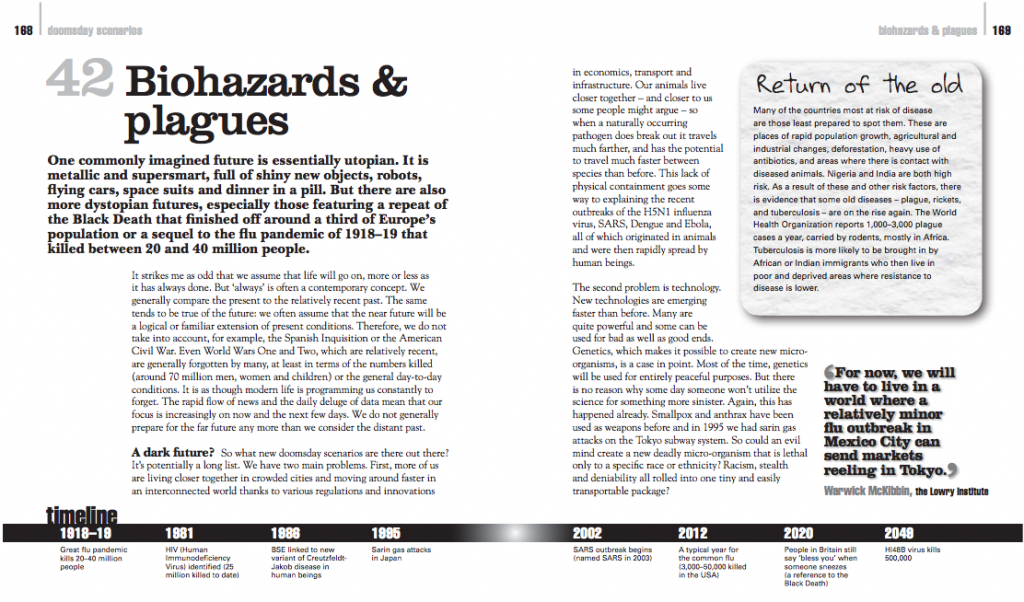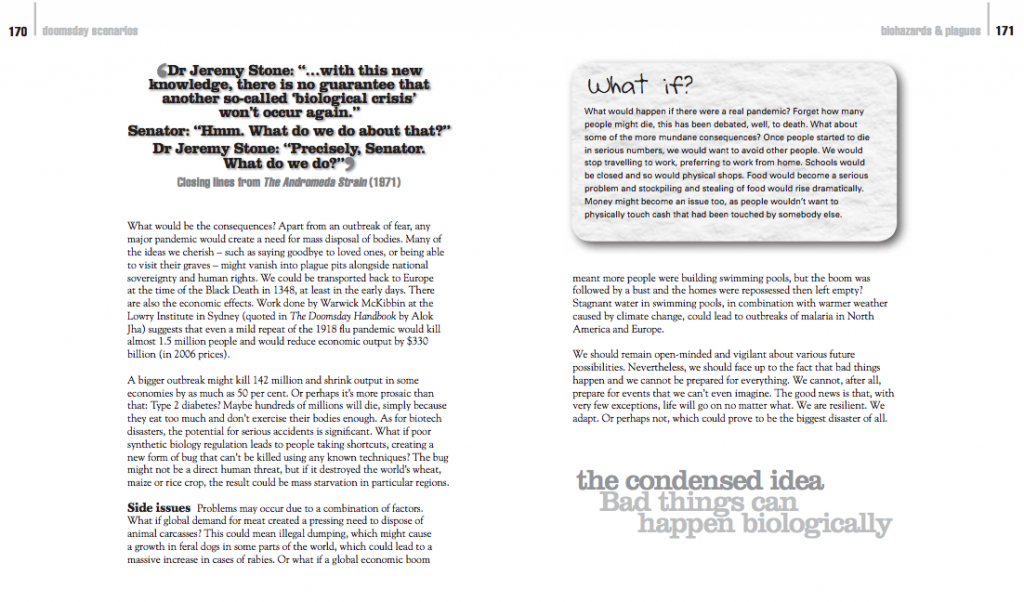i just remembere that i wrote this back in 2012 for a book called The Future: 50 Ideas you really need to know. Of course, if you write enough, and then wait long enough, almost anything can come true.


The text below is from the draft, so doesn’t exactly appear above.
41 Biohazards & Plagues
You might have noticed that some of the previous ideas where perhaps getting a little silly. Or perhaps I was. No drama. This next lot of ideas will soon sort us all out. Instead of intelligent machines, immortality and alien life how about a few mass extinctions, genetic terrorism or some good old-fashioned plagues?
Something, sometimes, strikes me as rather odd. Namely that we somehow assume that life will go on, more or less as it has always done. But ‘always’ is actually a rather contemporary concept. We compare the present to the relatively recent past. This we do not take into account, for example, world wars one and two (around 70 million men, women and children killed) or the great flu pandemic of 1918-19 (somewhere in the region of 20-40 million dead). Going much further back we had the Black Death, which killed something like 30-60% of Europe’s population.
We’ve been lucky. So, what other doomsday scenarios are there out there? Well it’s another long list. The problem is essentially two-fold. First more of us are living closer together in crowded cities and moving around in an interconnected world more easily thanks to various regulations and innovations in transport and infrastructure. We’ve even got our animals closer together – and closer to us some might argue – than previously. This means that when something nasty like a naturally occurring pathogen does break out it travels much faster – and has the potential to travel much faster and further between species too. This goes some way to explain recent outbreaks of H5N1 virus, SARS, dengue and Ebola, all of which initially originated in Animals and were then spread by humans.
The second problem is technology. New technologies are emerging faster, many are quite powerful and many can be used in bad ways as well as good. Genetics is a case in point. Genetics means that it is possible to create new and novel micro-organisms. Most of the time genetics will be for peaceful and products purposes. But there is no reason why some day someone (it’s Dr Evil again) won’t do something a little more sinister. As usual this has happened already in a sense. Smallpox and anthrax have been used as weapons before and more recently we’ve had the sarin gas attacks on the Tokyo subway system where the result of a few deranged minds. So how about someone creating a new deadly micro-organism which, for instance, is only lethal to a specific race or ethnicity? Stealth and deniability all rolled into one.
Consequences? Apart from an outbreak of fear there would be an initial issue relating to the mass disposal of bodies. Many of the ideas we cherish – like saying good bye to loved ones or being able to visit their graves, might vanish. We would be back to plague pits, at least in the early days. There are also the economic effects.
Work done by Warwick McKibbin at the Lowry Institute in Sydney (quoted in Alok Jha’s book, The Doomsday Handbook) suggest that a mild repeat of the 1918 flu pandemic would kill almost 1.5 million people and would reduce economic output by b$330 billion (in 2006 prices).
A large repeat might kill 142 million and shrink output in some economies by as much as 50%. Or maybe it’s more prosaic than that. Maybe the next plague is Type-2 Diabetes? Maybe millions will die simply because they eat too much and don’t go outside and walk around enough. As for biotech disasters, the potential is serious mishaps is significant. What if poor synthetic biology regulation leads to people taking short-cuts, which leads to the creation of a new form of bug that can’t be got rid of using any known techniques? The bug might not be a problem on its own, but if it destroyed the world’s wheat, maize or rice crop the result could be mass starvation within particular regions.
Or maybe problems will occur from a combination of factors. What if global demands for meat creates issues surrounding the disposal of animal carcasses? This could cause a growth in feral dogs in some parts of the world that could lead to massive increases in rabies. Or what if a global economic boom meant more pool building swimming pools, but the boom is followed by bust and the homes are repossessed leading to stagnant water in swimming polls, which in combination with warmer weather caused by climate change leads to outbreaks of malaria?
BTW, worth pointing out the 2012 entry on the timeline for this, which reads: “A typical year for the common flu (3,000-5,000 killed in the USA). ” Context people, context.
